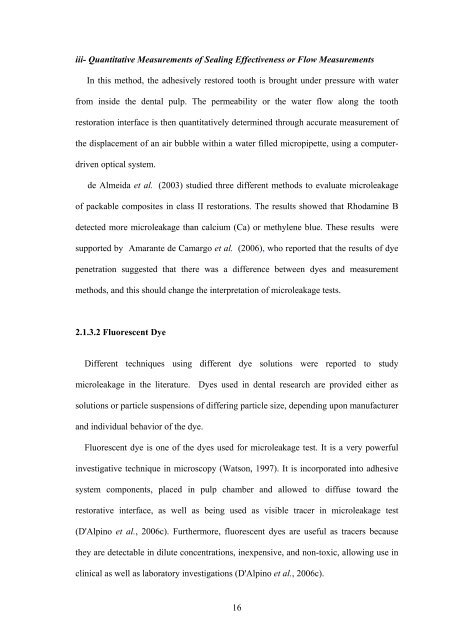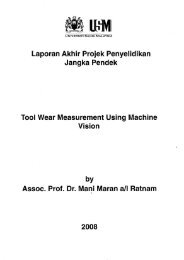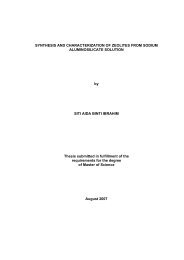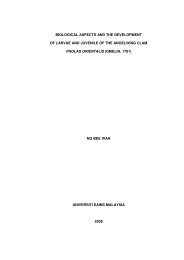microleakage in class ii composite restorations ... - ePrints@USM
microleakage in class ii composite restorations ... - ePrints@USM
microleakage in class ii composite restorations ... - ePrints@USM
Create successful ePaper yourself
Turn your PDF publications into a flip-book with our unique Google optimized e-Paper software.
<strong>ii</strong>i- Quantitative Measurements of Seal<strong>in</strong>g Effectiveness or Flow MeasurementsIn this method, the adhesively restored tooth is brought under pressure with waterfrom <strong>in</strong>side the dental pulp. The permeability or the water flow along the toothrestoration <strong>in</strong>terface is then quantitatively determ<strong>in</strong>ed through accurate measurement ofthe displacement of an air bubble with<strong>in</strong> a water filled micropipette, us<strong>in</strong>g a computerdrivenoptical system.(de Almeida et al., (2003) studied three different methods to evaluate <strong>microleakage</strong>of packable <strong>composite</strong>s <strong>in</strong> <strong>class</strong> II <strong>restorations</strong>. The results showed that Rhodam<strong>in</strong>e Bdetected more <strong>microleakage</strong> than calcium (Ca) or methylene blue. These results weresupported by (Amarante de Camargo et al., (2006), who reported that the results of dyepenetration suggested that there was a difference between dyes and measurementmethods, and this should change the <strong>in</strong>terpretation of <strong>microleakage</strong> tests.2.1.3.2 Fluorescent DyeDifferent techniques us<strong>in</strong>g different dye solutions were reported to study<strong>microleakage</strong> <strong>in</strong> the literature. Dyes used <strong>in</strong> dental research are provided either assolutions or particle suspensions of differ<strong>in</strong>g particle size, depend<strong>in</strong>g upon manufacturerand <strong>in</strong>dividual behavior of the dye.Fluorescent dye is one of the dyes used for <strong>microleakage</strong> test. It is a very powerful<strong>in</strong>vestigative technique <strong>in</strong> microscopy (Watson, 1997). It is <strong>in</strong>corporated <strong>in</strong>to adhesivesystem components, placed <strong>in</strong> pulp chamber and allowed to diffuse toward therestorative <strong>in</strong>terface, as well as be<strong>in</strong>g used as visible tracer <strong>in</strong> <strong>microleakage</strong> test(D'Alp<strong>in</strong>o et al., 2006c). Furthermore, fluorescent dyes are useful as tracers becausethey are detectable <strong>in</strong> dilute concentrations, <strong>in</strong>expensive, and non-toxic, allow<strong>in</strong>g use <strong>in</strong>cl<strong>in</strong>ical as well as laboratory <strong>in</strong>vestigations (D'Alp<strong>in</strong>o et al., 2006c).16
















